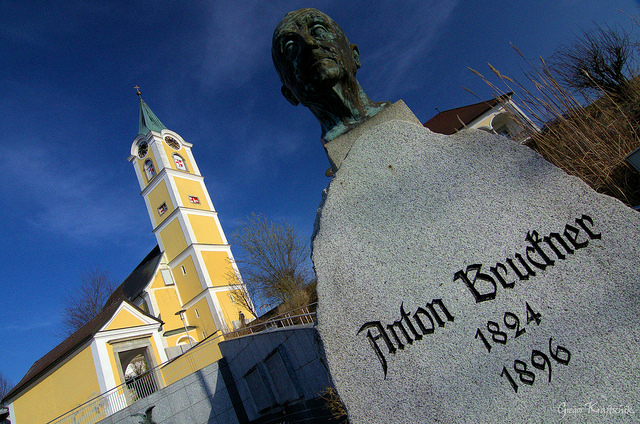How Bruckner Brought The Symphony Back to Life
The Brahms frenemy was loved by Nazis.

As summer draws to a close and I go insane the way I do every single August, I thankfully remembered this past week that I am a mere month away from the beginning of my symphony subscription. This was a birthday gift I bought for myself that I’ve had to wait almost six months to redeem. In late September, the first concerto I’ll go see is Bruckner’s Symphony No. 4 which, you know, we’ll get there when we get there. So this week let’s look at Bruckner’s Symphony No. 7 (Daniel Barenboim, Chicago Symphony Orchestra).
It’s possible you have no idea who Anton Bruckner is. That’s perfectly okay! I will admit to you that outside of name alone, I had never knowingly listened to or played his music. I very stupidly thought he was English? Look, I don’t know. A big thing to remember about this column is that I am just a huge moron with access to Spotify and Google Docs. Anyway. Anton Bruckner (first name actually Josef… are you one of those people who goes by your middle name? Why? Tell me) was an Austrian composer, living in the shadow of the likes of Wagner and Liszt, a contemporary and sort of enemy of Brahms, who lived from 1824 to 1896. His legacy was complicated and strange: he began in religious music before “pivoting” (internet phrase) to symphonies, a form altogether considered dead by the time he took it up, and did not achieve fame until very late in his life.
His music was also celebrated by—please insert an extremely long sigh here—Adolf Hitler and the Nazi party. In fact, it was this symphony, Symphony No. 7’s Adagio that was played on the radio when Hitler died. Uhhhhh… how about don’t do that??? It should go without saying that this column does not endorse Nazis, and that I am going to look at this piece outside of that context before it does not matter to me. It was not as if Bruckner wrote in his will, “please give my music to Hitler” or his dying words were, “I want this music to be taken out of context and given to the world’s worst people.” So. Okay.
One of the reasons it was smart of me (good job, me) to cover Beethoven’s Symphony No. 9 relatively early into this column is because so many composers took from it in various ways throughout the 19th century, Bruckner especially. In the opening refrain of the first movement, Allegro Moderato featuring the cellos (!!) echoes that of Beethoven’s. There’s a prologue-like nature to it, with a creeping uneasiness prevalent throughout. Bruckner’s music is very similar to Brahms in a lot of ways, but his symphonies are broader, wider, more reaching. There’s a desperation to them which is not romantic but almost philosophical: he was trying to prove why the form still mattered. Remember, this is the late 19th century—Symphony No. 7 was composed between 1881-3—and the Romantics were all about their “tone poems” and “symphonic dances” and “overtures.” No one was thinking about the symphony, not really, not seriously, as a form that could still mean something. If all of this is too heavy for you, allow me to recommend a little excerpt at the 10:16 mark that creeps in out of nowhere and introduces a mischievous theme. Though his music was written with very serious intentions, there is a lot of beauty and joy to it.
And length. These movements are long. The Adagio is a whopping 23 minutes: that’s TV, buddy, not music. Again, though, this is a man whose main inspiration was Beethoven, who never worried about taking up as much time as he needed to. In turn, Bruckner’s Adagio is spacious and expansive. It’s a landscape of a piece of music: at times trenchant and sharp, others soft and dulcet. You may recognize parts of this movement––it is the most famous within the symphony––around the 8:07 mark, a melody simultaneously grieving and triumphant. It was in the midst of writing this movement that Bruckner was said to have had a premonition of Wagner’s death; Wagner did, in fact, die before the completion of this symphony, and its debut was at a benefit to raise money for a statue of the deceased composer.
The Scherzo that follows the Adagio is quite a welcome gear shift. At a mere 10 and a half minutes in length, it jogs along with a constant conversation between the brass and strings. Its first minute is a joyride, a full-bodied crescendo into its central melody. After the big fanfare, it drops off for a few seconds before building back up yet again. This piece—and it could be late August talking—reminds me of a wave pool, ebbing and flowing between still waters and the crashing surf.
The Finale almost feels a little coquettish compared to the three movements that preface it. Not unlike Beethoven, however, Bruckner is trying to rebuild the momentum from literal scratch for this movement. There are some recapitulations of theme—harsher, more defiant in nature. Once it does get to those final few minutes, it does lack a specific internal joy that Beethoven harnessed. But that’s okay, this is Bruckner, after all. He’s allowed to have a different tone: this one is beautiful in its own right. Just like the adagio, it feels sweeping and all encompassing, as if a giant hand is gathering the orchestra and bringing it all together. And it feels like a more of a magic act as well when, at the 11-minute mark, it’s still building and growing. How will he do it? How will it feel? It feels like the symphony still has power and worth, even so many years after Beethoven perfected it.
Image: Red Greg via Flickr
